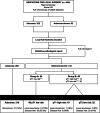Local full-thickness excision for sessile adenoma and cT1-2 rectal cancer: long-term oncological outcome
- PMID: 35732844
- PMCID: PMC9467953
- DOI: 10.1007/s00423-022-02593-7
Local full-thickness excision for sessile adenoma and cT1-2 rectal cancer: long-term oncological outcome
Abstract
Purpose: We analyzed all patients who underwent local transanal surgery at our institution to determine oncological outcomes and perioperative risk.
Methods: In 1997, we developed a prospective protocol for rectal tumors: transanal local full-thickness excision was considered curative in patients with benign adenoma and early cancers. In this analysis, 404 patients were included. To analyze survival, only those patients exposed to the risk of dying for at least 5 years were considered for the study.
Results: The final pathological analysis revealed that 262 (64.8%) patients had benign lesions, whereas 142 had malignant lesions. Postoperative complications were recorded in 12.6%. At the median time of 21 months, 14% of the adenomas and 12% of cancers had recurred, half of which were surgically resected. The overall 5-year survival rate was 94%.
Conclusion: With similar outcomes and significantly lower morbidity, we found local surgery to be an adequate alternative to radical surgery in selected cases of early rectal cancer.
Keywords: Local surgery; Oncological outcome; Rectal adenoma; Rectal cancer; Rectal surgery; Transanal endoscopic microsurgery.
© 2022. The Author(s).
Conflict of interest statement
JMRR shares a rectoscope patent from Richard Word GmbH. MAGD, VAD, TMT, AG, and JV have no conflicts of interest to disclose.
Figures


Similar articles
-
Management and outcome of local recurrence following transanal endoscopic microsurgery for rectal cancer.Dis Colon Rectum. 2012 Mar;55(3):262-9. doi: 10.1097/DCR.0b013e318241ef22. Dis Colon Rectum. 2012. PMID: 22469792
-
Transanal endoscopic microsurgery for rectal neoplasms. How I do it.J Gastrointest Surg. 2013 Mar;17(3):586-92. doi: 10.1007/s11605-012-2060-x. Epub 2012 Oct 24. J Gastrointest Surg. 2013. PMID: 23093450
-
Transanal endoscopic microsurgery for rectal tumors: experience at Korea's National Cancer Center.Surg Endosc. 2009 Nov;23(11):2575-9. doi: 10.1007/s00464-009-0466-7. Epub 2009 Apr 4. Surg Endosc. 2009. PMID: 19347399
-
[Transanal endoscopic microsurgery for tumours in rectum].Tidsskr Nor Laegeforen. 2007 Nov 15;127(22):2954-8. Tidsskr Nor Laegeforen. 2007. PMID: 18026244 Review. Norwegian.
-
Surgical resection of rectal adenoma: a rapid review.World J Gastroenterol. 2009 Aug 21;15(31):3851-4. doi: 10.3748/wjg.15.3851. World J Gastroenterol. 2009. PMID: 19701964 Free PMC article. Review.
Cited by
-
Local excision for middle-low rectal cancer after neoadjuvant chemoradiation: A retrospective study from a single tertiary center.World J Gastrointest Oncol. 2024 Dec 15;16(12):4614-4624. doi: 10.4251/wjgo.v16.i12.4614. World J Gastrointest Oncol. 2024. PMID: 39678786 Free PMC article.
References
MeSH terms
Grants and funding
LinkOut - more resources
Full Text Sources

